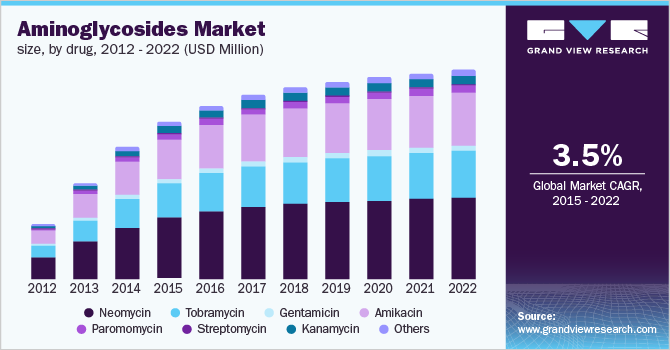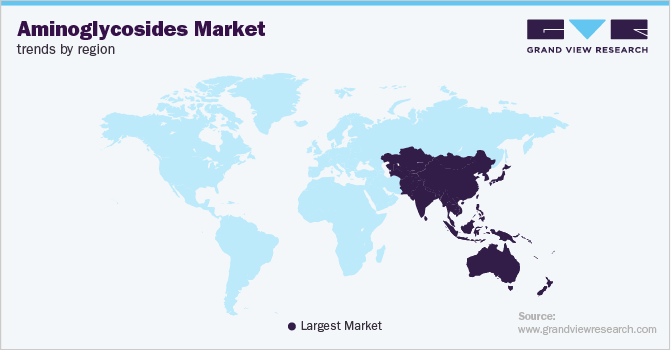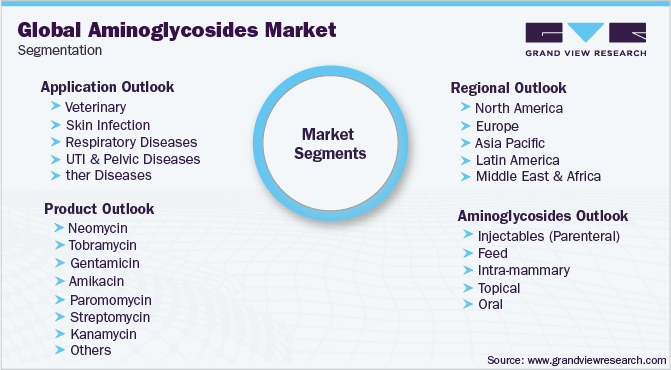- Home
- »
- Pharmaceuticals
- »
-
Aminoglycoside Market Size & Share, Industry Report, 2022GVR Report cover
![Aminoglycosides Market Size, Share & Trends Report]()
Aminoglycosides Market Size, Share & Trends Analysis Report By Drug (Neomycin, Tobramycin, Gentamicin, Amikacin, Paromomycin, Streptomycin, Kanamycin), By Mode Of Administration, By Application, By Region, And Segment Forecasts, 2015 - 2022
- Report ID: 978-1-68038-630-1
- Number of Report Pages: 105
- Format: PDF, Horizon Databook
- Historical Data: 2010-2012
- Forecast Period: 2016 - 2022
- Industry: Healthcare
Report Overview
The global aminoglycosides market size to be valued at USD 1.68 billion by 2022 and is expected to grow at a compound annual growth rate (CAGR) of 3.5% during the forecast period, owing to the rising incidence of bacterial infections caused by gram-positive and gram-negative bacteria. Usage of these drugs in the treatment of different bacterial infections in humans as well as animals owing to presence of characteristics such as bactericidal, concentration-dependent killing action, and activity against staphylococci and certain mycobacteria is expected to influence industry growth. Moreover, this class of antibiotics is found to be effective even when bacterial inoculum is large, and are frequently used as a second line of defense against basic infection resistant to basic antibacterials. This treatment related application of drugs from this class is an important factor expected to drive growth.

Rising incidence of tuberculosis is expected to fuel demand for aminoglycosides, especially in low-income countries where the incidence is alarmingly high and there is a need for TB drug regimens. Introduction of digital health agenda by WHO and ERS (European Respiratory Society) for eradication of tuberculosis is expected to boost demand.
Additionally, the presence of Global Drug Facility and UNITAID that serve as an intervention for international tuberculosis diagnosis and management is expected to increase drug demand. Presence of yearly procurement requirement by GDF and STOP TB Foundation are anticipated to pose potential in this market owing to rising cases of MDR-TB.
However, toxic effects associated with use of these drugs that include muscle twitching, irreversible hearing loss, and seizure are responsible for restrictive growth in this industry. Other factors that are expected to attribute for restrictive growth include reduction in sale of aminoglycoside antibiotics such as neomycin, streptomycin, and apramycin. Reduction in sales is the result of reduced consumption in production of combinatorial pharmaceuticals which involve usage of intramammary and injectable aminoglycosides.
Aminoglycosides Market Trends
Increased animal infectious diseases, high antibiotic usage, an aging population, and an increase in the prevalence of bacterial infectious diseases are the primary factors driving the aminoglycosides market expansion. The antibacterial effect against staphylococci and other viruses is expanding the use of aminoglycosides in treating a variety of bacterial infections in humans and animals, which is expected to drive the industry expansion.
Antibiotics found are effective even when the bacterial inoculum is enormous, and they are frequently utilized as a protection mechanism against primary infections resistant to basic antibacterial. The rising burden of tuberculosis is also expected to drive demand for aminoglycosides.
The reduction in the prescription frequency of aminoglycoside antibiotics treatment-related side effects like severe toxicities, kidney damage, and neurological blockage is expected to hamper the global market growth.
The growing use of aminoglycosides in tuberculosis therapy creates demand in these regions for aminoglycosides. The rising disposable income and a high aging population in emerging economies like China and India are expected to drive the market. Leading generics producers, quickly increasing pharmaceutical sectors, and cheap clinical trial costs are expected to create better opportunities for the market.
Product Insights
Neomycin, streptomycin, gentamicin, kanamycin, tobramycin, amikacin, and others are included in the product categorization of aminoglycosides. Streptomycin is a first level antibacterial used for treatment of tuberculosis. Aminoglycosides used in the treatment of MDR-TB include kanamycin capreomycin, and amikacin.
Gentamicin is the agent of choice for major bacterial infections amongst others. Tobramycin has been found to be slightly more effective against Pseudomonas aeruginosa infections. Amikacin and gentamicin find maximum usage in veterinary medicine.
Use of kanamycin in MDR-TB is recommended after failure of capreomycin but before treatment with amikacin However, presence of substitutes such as amikacin is expected to restrain kanamycin demand as amikacin was found to be more effective at critical concentration as compared to capreomycin and kanamycin on testing their efficacies on the wild-type M. tuberculosis. In addition to low minimum inhibitory concentration (MIC) it is also observed that this drug shows comparatively better pharmacodynamic properties and is also tolerable for pediatric patients.
Scanty provision of quality assured active pharmaceutical ingredient and WHO-GMP compliant product for capreomycin and kanamycin is a major factor that leads in failure of pre-qualification of these drug thus restraining sector growth in more developed countries. Vulnerable state of supply for sources of capreomycin and kanamycin approved through WHO prequalification are expected to result into restrictive market growth.
Route of Administration Insights
Administration of aminoglycosides is done by various routes depending upon the type & site of infection and whether the drug is used for a human or non-human patient. These can be administered in the form of feed, injectable (parenteral), intra-mammary, oral, and topical methods. Injectable administration accounted for the largest share, as this route is preferred for human medical usage more because it provides the optimum mode of drug action mechanism through intravenous or intramuscular route for treatment.
Oral use of aminoglycoside antibiotic is usually for bowel surgery in order to prevent infection at the time of surgery. However, poor absorption rate of these antibiotics is attributive towards the route’s comparatively lesser share in market revenue.
Owing to the presence of effective activity of aminoglycoside antibiotics against E. coli, Proteus, Pseudomonas, Salmonella, Shigella, Serratia, and Enterobacter in animals, these drugs are of significant use in veterinary medicine in the form of feed for increasing bioavailability of the drug. Majority of the sales of in-feed and in-water aminoglycoside products is carried out in poultry and pig industries.
Application Insights
Depending on usage and type of infection, aminoglycosides’ applications are segregated into skin, respiratory, UTI & pelvic diseases, neonatal sepsis, and veterinary uses. Use of aminoglycosides for respiratory infections such as tuberculosis accounted for the maximum share in revenue in 2014 owing to higher incidence of tuberculosis in the developing regions across the globe.
Furthermore, increase in incidences of multi-drug resistant tuberculosis is attributive towards growth in this segment. Rise in funding to the international organizations that are engaged in provision of subsidized tuberculosis treatment is anticipated to enhance demand for second line defense drugs over the forecast period.
However, veterinary usage of aminoglycosides is expected to witness restricted growth through to 2022 as a consequence of reduction in usage in order to prevent side effects and resistance development from food that is produced from animals treated with aminoglycosides.
Regional Insights
Asia Pacific accounted for the largest share of revenue in 2014 that is due to higher incidence rate of multi-drug resistant tuberculosis that needs second line drugs for treatment is attributive towards a larger considerably larger share of kanamycin and capreomycin in the Asia Pacific region along with the significant availability of other aminoglycosides as well.

Furthermore, presence of a number of market entities in economies such as Japan, China and India are attributive towards the high potential for market share in this region over the forecast period. Major suppliers for kanamycin are located in the regions that provide kanamycin to GDF for STOP TB program thereby adding to the revenue in the industry.
Unavailability of aminoglycosides such as kanamycin, streptomycin and dihydrostreptomycin in the U.S. are attributive towards reduce market revenue in this region.
Variations in antibiotic resistance across countries of different regions are responsible, in part, for different volumes, patterns, and revenue generation for aminoglycoside consumption.
Key Companies & Market Share Insights
Key participants of the industry include Kremoint Pharma Pvt. Ltd, Vega Pharma Ltd., Jiangxi Bolai Pharmacy Co., Ltd., Xian Wison Biological Technology Co., Ltd., Hangzhou Uniwise International Co., Ltd., HuvePharma, Yi Chang Veterinary Medicine Factory, Medson Pharmaceuticals, Medico Remedies Pvt. Ltd.
Due to the unavailability of manufacturers and suppliers of some aminoglycoside antibiotics, new participants are expected enter the market, but lack of regulatory approval is expected to hamper their market entry. Furthermore, associated side effects with the currently available drugs are also expected to encourage manufacturers to shift focus towards production of relatively more viable substitutes.
Recent Developments
-
In November 2020, Huvepharma Inc. launched AVERT NE, a novel new vaccination designed to help manage necrotic enteritis caused by Clostridium perfringens Type A. Curtiss Healthcare, Inc.'s exclusive and proprietary transgenic attenuated Salmonella vaccine (RASV) technology is used as the delivery platform for AvertNE to elicit an autoimmune reaction and prevent hens from necrotic enteritis.
-
In November 2021, Huvepharma, a leading company in human and animal nutrition and health, announced Huve Nutraceuticals, a partnership for the massive manufacturing of vegan omega-three algal oils for the enterprise market.
Aminoglycosides Market Report Scope
Report Attribute
Details
Revenue forecast in 2022
USD 1.68 billion
Growth rate
CAGR of 3.5 from 2015 to 2022
Base year for estimation
2014
Historical data
2010 - 2012
Forecast period
2015 - 2022
Quantitative units
Revenue in USD billion and CAGR from 2015 to 2022
Report coverage
Revenue forecast, company ranking, competitive landscape, growth factors, and trends
Segments covered
Product, Route of Administration, Application, region
Regional scope
North America, Europe, Asia Pacific, Latin America and MEA
Country scope
U.S., Canada, U.K., Germany, China, Japan, Brazil, South Africa
Key companies profiled
Vega Pharma Ltd., Kremoint Pharma Pvt. Ltd, Xian Wison Biological Technology Co., Ltd., Jiangxi Bolai Pharmacy Co., Ltd., Medson Pharmaceuticals, Hangzhou Uniwise International Co., Ltd.
Customization scope
Free report customization (equivalent to up to 8 analysts working days) with purchase. Addition or alteration to country, regional & segment scope.
Pricing and purchase options
Avail customized purchase options to meet your exact research needs. Explore purchase options
Global Aminoglycosides Market Segmentation
This report forecasts revenue growth at global, regional & country levels and provides an analysis on the latest trends and opportunities in each of the sub-segments from 2015 to 2022. For the purpose of this study, Grand View Research has segmented the aminoglycosides market on the basis of product, route of administration, application, and region.

-
Product Outlook (Market Revenue in USD Million, 2012 - 2022 )
-
Neomycin
-
Tobramycin
-
Gentamicin
-
Amikacin
-
Paromomycin
-
Streptomycin
-
Kanamycin
-
Others
-
-
Outlook, by Route of Administration (Market Revenue in USD Million, 2012 - 2022 )
-
Injectables (Parenteral)
-
Feed
-
Intra-mammary
-
Topical
-
Oral
-
-
Application Outlook (Market Revenue in USD Million, 2012 - 2022 )
-
Veterinary
-
Skin Infection
-
Respiratory diseases
-
UTI & Pelvic Diseases
-
Other diseases
-
-
Regional Outlook (Market Revenue in USD Million, 2012 - 2022 )
-
North America
-
U.S.
-
Canada
-
-
Europe
-
Germany
-
UK
-
-
Asia Pacific
-
China
-
Japan
-
-
Latin America
-
Brazil
-
-
MEA
-
South Africa
-
-
Frequently Asked Questions About This Report
b. The global aminoglycosides market size was estimated at USD 1.1 billion in 2019 and is expected to reach USD 1.3 billion in 2020.
b. The global aminoglycosides market is expected to grow at a compound annual growth rate of 1.5% from 2019 to 2022 to reach USD 1.7 billion by 2022.
b. North America dominated the aminoglycosides market with a share of 23.2% in 2019. This is attributable to the high penetration of pharmaceutical manufacturers in the U.S. coupled with a well-established regulatory system to guide drug manufacturing.
b. Some key players operating in the aminoglycosides market include Kremoint Pharma Pvt. Ltd, Vega Pharma Ltd., Jiangxi Bolai Pharmacy Co., Ltd., Xian Wison Biological Technology Co., Ltd., Hangzhou Uniwise International Co., Ltd., HuvePharma, Yi Chang Veterinary Medicine Factory, Medson Pharmaceuticals, Medico Remedies Pvt. Ltd.
b. Key factors that are driving the aminoglycosides market growth include increasing rising incidence of tuberculosis and increased drug demand for tuberculosis diagnosis and management.
Share this report with your colleague or friend.
![gvr icn]()
NEED A CUSTOM REPORT?
We can customize every report - free of charge - including purchasing stand-alone sections or country-level reports, as well as offer affordable discounts for start-ups & universities. Contact us now
![Certified Icon]()
We are GDPR and CCPA compliant! Your transaction & personal information is safe and secure. For more details, please read our privacy policy.
We are committed towards customer satisfaction, and quality service.
"The quality of research they have done for us has been excellent."





